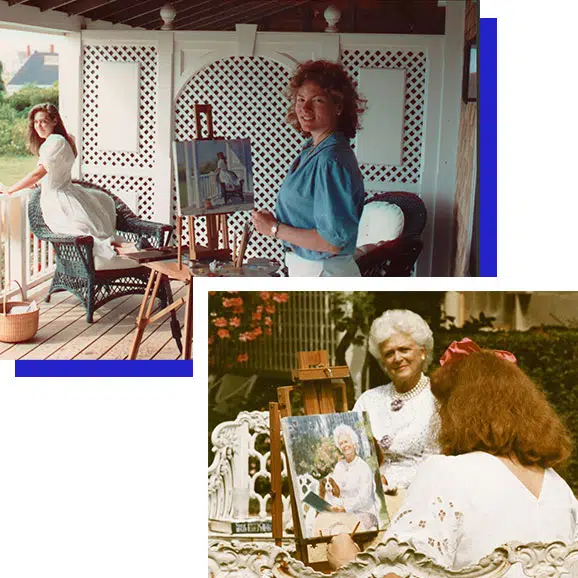
My Beginning
Passionate, Inspired, Impressionable
From the moment she took a red crayon from the hands of her artist mother, Candace Lovely has never stopped coloring the world around her. Influenced in her youth by a love of Maxfield Parrish, having visited his studio across the Connecticut River from her childhood home, her first stirrings of impressionism were catapulted by her later discovery of Winslow Homer. Her natural gifts were refined studying in Vermont and in the ateliers of the Boston School, but a return to her beginnings defined her initial voice as a painter through her first award winning work, “Spencer Hollow Meadow.” From this collection of local imagery birthed a desire to capture the “feel” of a place and a people – to create a canvas that imparts peace, familiarity, tradition, and appreciation for life.
My Beginning
Passionate, Inspired, Impressionable
From the moment she took a red crayon from the hands of her artist mother, Candace Lovely has never stopped coloring the world around her. Influenced in her youth by a love of Maxfield Parrish, having visited his studio across the Connecticut River from her childhood home, her first stirrings of impressionism were catapulted by her later discovery of Winslow Homer. Her natural gifts were refined studying in Vermont and in the ateliers of the Boston School, but a return to her beginnings defined her initial voice as a painter through her first award winning work, “Spencer Hollow Meadow.” From this collection of local imagery birthed a desire to capture the “feel” of a place and a people – to create a canvas that imparts peace, familiarity, tradition, and appreciation for life.

Working with Shadows
Candace Lovely speaks often of creating paintings that allow the viewer to be voyeur. This short piece invites you to sit as voyeur live as Lovely creates “drama on canvas.” Starting tabula rasa in plein air, watch as she structures in primary blue, filling in the utter tranquility of a Lowcountry scene, searching for tidal waters between the pillars of pine, palm, and live oak. “Form is made where highlight meets shadow,” Lovely teaches, explaining technique with a nod to the deeper illustration of how we see the world. “You don’t paint the subject, you paint the shadow, then you paint the light. The picture becomes clear when the light and dark come together.”
Working with Shadows
Candace Lovely speaks often of creating paintings that allow the viewer to be voyeur. This short piece invites you to sit as voyeur live as Lovely creates “drama on canvas.” Starting tabula rasa in plein air, watch as she structures in primary blue, filling in the utter tranquility of a Lowcountry scene, searching for tidal waters between the pillars of pine, palm, and live oak. “Form is made where highlight meets shadow,” Lovely teaches, explaining technique with a nod to the deeper illustration of how we see the world. “You don’t paint the subject, you paint the shadow, then you paint the light. The picture becomes clear when the light and dark come together.”
Mastering Your Medium
Candace Lovely celebrates the idea that “anyone can be an artist” and teaches you how, using Manet’s theory of color. More significantly, she brought this concept to market with her Color with Candace Whittemore Lovely Coloring Books, making this technique and the ease of artistic creation accessible to all audiences. “It doesn’t take years of training or master’s degree in art ... you can begin painting like an impressionist simply by using 3 primary colors,” she explains of her books which include still life, porches, Boston, and more. Lovely created the series to familiarize audiences with the 3-color technique and to connect people to the “beauty and tranquility” of not just viewing art but mastering the ability to create it themselves.
Mastering Your Medium
Candace Lovely celebrates the idea that “anyone can be an artist” and teaches you how, using Manet’s theory of color. More significantly, she brought this concept to market with her Color with Candace Whittemore Lovely Coloring Books, making this technique and the ease of artistic creation accessible to all audiences. “It doesn’t take years of training or master’s degree in art ... you can begin painting like an impressionist simply by using 3 primary colors,” she explains of her books which include still life, porches, Boston, and more. Lovely created the series to familiarize audiences with the 3-color technique and to connect people to the “beauty and tranquility” of not just viewing art but mastering the ability to create it themselves.

